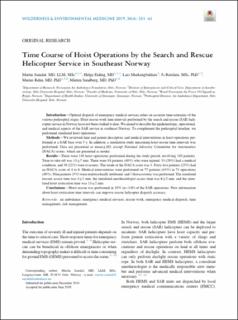| dc.contributor.author | Samdal, Martin | |
| dc.contributor.author | Eiding, Helge | |
| dc.contributor.author | Markengbakken, Lars | |
| dc.contributor.author | Røislien, Jo | |
| dc.contributor.author | Rehn, Marius | |
| dc.contributor.author | Sandberg, Mårten | |
| dc.coverage.spatial | Norway | en_US |
| dc.date.accessioned | 2020-05-20T07:58:54Z | |
| dc.date.available | 2020-05-20T07:58:54Z | |
| dc.date.created | 2020-01-15T10:24:41Z | |
| dc.date.issued | 2019-10 | |
| dc.identifier.citation | Samdal, M., Eiding, H., Markengbakken, L. et al. (2019) Time Course of Hoist Operations by the Search and Rescue Helicopter Service in Southeast Norway. Wilderness & environmental medicine, 30 (4), 351-361. | en_US |
| dc.identifier.issn | 1080-6032 | |
| dc.identifier.uri | https://hdl.handle.net/11250/2655081 | |
| dc.description.abstract | Introduction
Optimal dispatch of emergency medical services relies on accurate time estimates of the various prehospital stages. Hoist rescue work time intervals performed by the search and rescue (SAR) helicopter service in Norway have not been studied to date. We aimed to describe the epidemiologic, operational, and medical aspects of the SAR service in southeast Norway. To complement the prehospital timeline, we performed simulated hoist operations.
Methods
We reviewed time and patient descriptors and medical interventions in hoist operations performed at a SAR base over 5 y. In addition, a simulation study measuring hoist rescue time intervals was performed. Data are presented as mean±SD, except National Advisory Committee for Aeronautics (NACA) scores, which are presented as modes.
Results
There were 148 hoist operations performed during the study period, involving 180 patients. Time to take-off was 13±7 min. There were 88 patients (49%) who were injured; 53 (29%) had a medical condition, and 39 (22%) were evacuees. The mode of the NACA score was 3. Forty-five patients (25%) had an NACA score of 4 to 6. Medical interventions were performed on 77 patients (43%) in 73 operations (49%). Nine patients (5%) were endotracheally intubated, and 1 thoracostomy was performed. The simulated rescuer access time was 4±2 min, the simulated anesthesiologist access time was 6±2 min, and the simulated hoist extrication time was 13±2 min.
Conclusions
Hoist rescue was performed in 10% (n=148) of the SAR operations. New information about hoist extrication time intervals can improve rescue helicopter dispatch accuracy. | en_US |
| dc.language.iso | eng | en_US |
| dc.publisher | Elsevier Ltd. | en_US |
| dc.rights | Attribution-NonCommercial-NoDerivatives 4.0 Internasjonal | * |
| dc.rights.uri | http://creativecommons.org/licenses/by-nc-nd/4.0/deed.no | * |
| dc.subject | HEMS | en_US |
| dc.subject | luftambulanse | en_US |
| dc.subject | redningsoperasjoner | en_US |
| dc.subject | redningstjenester | en_US |
| dc.subject | Norsk luftambulanse | en_US |
| dc.title | Time Course of Hoist Operations by the Search and Rescue Helicopter Service in Southeast Norway | en_US |
| dc.type | Peer reviewed | en_US |
| dc.type | Journal article | en_US |
| dc.description.version | publishedVersion | en_US |
| dc.rights.holder | © 2019 The Authors. | en_US |
| dc.subject.nsi | VDP::Medisinske Fag: 700 | en_US |
| dc.source.pagenumber | 351-361 | en_US |
| dc.source.volume | 30 | en_US |
| dc.source.journal | Wilderness & environmental medicine | en_US |
| dc.source.issue | 4 | en_US |
| dc.identifier.doi | 10.1016/j.wem.2019.06.004 | |
| dc.identifier.cristin | 1773424 | |
| cristin.ispublished | true | |
| cristin.fulltext | original | |
| cristin.qualitycode | 1 | |

